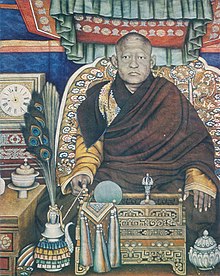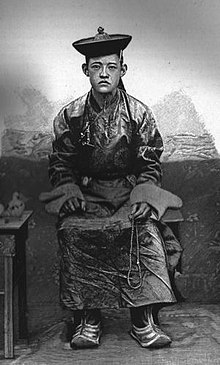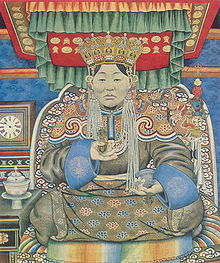Bogd Khan: Difference between revisions
No edit summary |
proofreading |
||
| Line 10: | Line 10: | ||
| spouse = Sharav Dondogdulam |
| spouse = Sharav Dondogdulam |
||
}} |
}} |
||
The '''Bogd Khan''' ([[Mongolian language|Mongolian]] {{lang|mn|Богд хаан}}; 1869–1924) was enthroned as the Great Khaan (Emperor) ([[Khan (title)|Khan]]) of [[Outer Mongolia, 1911-1919|Mongolia]] on 29 December 1911, when [[Outer Mongolia]] declared independence from the [[Qing Dynasty]] after the [[Xinhai Revolution]]. He was born in [[Kham]] region of eastern [[Tibet]], |
The '''Bogd Khan''' ([[Mongolian language|Mongolian]] {{lang|mn|Богд хаан}}; 1869–1924) was enthroned as the Great Khaan (Emperor) ([[Khan (title)|Khan]]) of [[Outer Mongolia, 1911-1919|Mongolia]] on 29 December 1911, when [[Outer Mongolia]] declared independence from the [[Qing Dynasty]] after the [[Xinhai Revolution]]. He was born in the [[Kham]] region of eastern [[Tibet]], today's [[Sichuan]] province of the[[People's Republic of China]]. As the eighth [[Jebtsundamba Khutuktu]] (Mongolian: Jevzundamba Khutagt), he was the third most important person in the Tibetan Buddhism hierarchy, below only the [[Dalai Lama|Dalai]] and [[Panchen Lama]]s, and therefore also known as the '''Bogdo Lama'''. He was the spiritual leader of Outer Mongolia's Tibetan [[Buddhism]]. His wife Tsendiin Dondogdulam, the Ekh Dagina ("[[Dakini]] mother"), was believed to be a manifestation of the bodhisattva White Tara. |
||
==Life== |
==Life== |
||
[[File:BogdKhan.jpg|thumb|Young Bogd Khan]] |
[[File:BogdKhan.jpg|thumb|Young Bogd Khan]] |
||
The future Bogd Khan was born in [[1869]] in the family of a Tibetan official.<ref>Soninbayar, Sh. and Punsaldulam, B. 2009. Mongolyn Tusgaar Togtnol Oyuun Sanaany Ikh Unirdagch VIII Bogd Jevzundamba Khutagt. Ulaanbaatar.</ref> The boy was officially recognized as the new incarnation of the [[Bogd Gegen]] in Potala |
The future Bogd Khan was born in [[1869]] in the family of a Tibetan official.<ref>Soninbayar, Sh. and Punsaldulam, B. 2009. Mongolyn Tusgaar Togtnol Oyuun Sanaany Ikh Unirdagch VIII Bogd Jevzundamba Khutagt. Ulaanbaatar.</ref> The boy was officially recognized as the new incarnation of the [[Bogd Gegen]] in Potala in the presence of the 13th Dalai Lama and the Panchen Lama.<ref>Knyazev, N.N. The Legendary Baron. - In: Legendarnyi Baron: Neizvestnye Stranitsy Grazhdanskoi Voiny. Moscow: KMK Sci. Press, 2004, ISBN 5-87317-175-0 p. 67</ref> The new Bogd Gegen arrived in [[Ulan Bator|Urga]], the capital of [[Outer Mongolia]], in 1874. After this he lived only in Mongolia. |
||
According to one eyewitness,"''...he did not become a puppet in the hands of lamas but, on the opposite, took them in hands. Since his yong years he wanted to restore the great Mongolian kingdom of Genghis Khan or, at least, to liberate Mongolia from the Chinese and make it self-dependent. Local princes feared him, but masses liked... Independent and clever first hierarch and ruler was unacceptable neither for Tibet, nor for the Chinese''".<ref>Tornovsky, M.G. Events in Mongolia-Khalkha in 1920-1921. - In: Legendarnyi Baron: Neizvestnye Stranitsy Grazhdanskoi Voiny. Moscow: KMK Sci. Press, 2004, ISBN 5-87317-175-0 p. 181</ref> |
According to one eyewitness,"''...he did not become a puppet in the hands of lamas but, on the opposite, took them in hands. Since his yong years he wanted to restore the great Mongolian kingdom of Genghis Khan or, at least, to liberate Mongolia from the Chinese and make it self-dependent. Local princes feared him, but masses liked... Independent and clever first hierarch and ruler was unacceptable neither for Tibet, nor for the Chinese''".<ref>Tornovsky, M.G. Events in Mongolia-Khalkha in 1920-1921. - In: Legendarnyi Baron: Neizvestnye Stranitsy Grazhdanskoi Voiny. Moscow: KMK Sci. Press, 2004, ISBN 5-87317-175-0 p. 181</ref> |
||
As a result, |
As a result, from his young years the 8th Bogd Gegeen was the subject of intrigues of Qing officials in Urga. Later he became the subject of [[propaganda]] campaigns organised by Mongolian [[Communism|Communists]], which attacked him as a prolific poisoner, a [[paedophile]], and a [[libertine]], which was later repeated in [[belles-lettres]] and other non-scientific literature (e.g. James Palmer). However, analysis of documents stored in Mongolian and Russian archives does not confirm these statements.<ref>Batsaikhan, O. Bogdo Jebtsundamba Khutuktu, the last King of Mongolia. Ulaanbaatar: Admon Publ., 2008, ISBN 978-99929-0-464-X.</ref><ref>Kuzmin, S.L. and Oyuunchimeg, J. The Great Khan of Mongolia, the 8th Bogd Gegeen. - Aziya i Afrika Segodnya (Moscow, Russian Acad. Sci. Publ.), 2009, no. 1, pp. 59-64.</ref> |
||
[[File:sharav dondogdulam.jpg|thumb|Bogd Khan's wife Tsendiin Dondogdulam]] |
[[File:sharav dondogdulam.jpg|thumb|Bogd Khan's wife Tsendiin Dondogdulam]] |
||
As a monk, the Bogd had limited access to physical means of imposing power, though some enemies were executed for [[blasphemy]]. The Polish traveller [[Ferdynand Antoni Ossendowski|Ferdinand Ossendowski]] recorded that he knew "every thought, every movement of the Princes and Khans, the slightest conspiracy against him, and the offender is usually kindly invited to [[Ulan Bator|Urga]], from where he does not return alive.<ref>Ferdinand Ossedowski, ''Beasts, Men and Gods'' (New York, E.P. Dutton & Co., 1922), 293.</ref> It should be noted, however, that Ossendovsky's claims for his acquaintance with the Bogd Gegen were not confirmed by comparative analysis of his book and manuscripts.<ref>Kuzmin, S.L., Rejt, L.J. Notes by F.A. Ossendowski as a source on the history of Mongolia. – Oriens (Moscow, Russian Acad. Sci. Publ.), 2008, no. 5, pp. 97-110.</ref> |
As a monk, the Bogd had limited access to physical means of imposing power, though some enemies were executed for [[blasphemy]]. The Polish traveller [[Ferdynand Antoni Ossendowski|Ferdinand Ossendowski]] recorded that he knew "every thought, every movement of the Princes and Khans, the slightest conspiracy against him, and the offender is usually kindly invited to [[Ulan Bator|Urga]], from where he does not return alive.<ref>Ferdinand Ossedowski, ''Beasts, Men and Gods'' (New York, E.P. Dutton & Co., 1922), 293.</ref> It should be noted, however, that Ossendovsky's claims for his acquaintance with the Bogd Gegen were not confirmed by comparative analysis of his book and manuscripts.<ref>Kuzmin, S.L., Rejt, L.J. Notes by F.A. Ossendowski as a source on the history of Mongolia. – Oriens (Moscow, Russian Acad. Sci. Publ.), 2008, no. 5, pp. 97-110.</ref> |
||
The Bogd Gegen |
The Bogd Gegen lost his power when Chinese troops [[Occupation of Mongolia|occupied the country]] in 1919. When [[Roman von Ungern-Sternberg|Baron Ungern]]'s forces failed to seize Urga in late 1920, the Bogd was placed under house arrest; then he was freed and reinstated by Ungern shortly before he took Urga in 1921.<ref>Kuzmin, S.L. The History of Baron Ungern. An Experience of Reconstruction. Moscow: KMK Sci. Press., ISBN 978-5-87317-692-2 p. 325-357</ref> After the revolution in 1921 led by [[Damdin Sükhbaatar]], the Bogd Khan was allowed to stay on the throne in a limited monarchy until his death in 1924, a year after that of his wife. |
||
After his death, the Mongolian Revolutionary government, led by followers of the Russian Communists, declared that no more reincarnations were to be found and established the [[Mongolian People's Republic]]. However, rumors about a reincarnation of the Jebtsundamba Khutuktu appeared in northern Mongolia in that same year.<ref>''Bawden C.R.'' The Modern History of Mongolia, 1968, Praeger publishers, New York, pp. 261-263</ref> No traditional determination of the supposed incarnation was conducted. Another rumor appeared in 1925. In November 1926 the 3rd Great Khural of Mongolian People's Republic approved a special resolution that searches of the Bogd Gegen |
After his death, the Mongolian Revolutionary government, led by followers of the Russian Communists, declared that no more reincarnations were to be found and established the [[Mongolian People's Republic]]. However, rumors about a reincarnation of the Jebtsundamba Khutuktu appeared in northern Mongolia in that same year.<ref>''Bawden C.R.'' The Modern History of Mongolia, 1968, Praeger publishers, New York, pp. 261-263</ref> No traditional determination of the supposed incarnation was conducted. Another rumor appeared in 1925. In November 1926 the 3rd Great Khural of Mongolian People's Republic approved a special resolution that searches for reincarnations of the the Bogd Gegen should not be allowed<ref>Kuzmin, S.L. and Oyuunchimeg, J. The Great Khan of Mongolia, the 8th Bogd Gegeen. - Aziya i Afrika Segodnya (Moscow, Russian Acad. Sci. Publ.), 2009, no. 1, pp. 59-64.</ref> A final prohibition was approved by the 7th Congress of the Mongolian People's Revolutionary Party and the 5th Great People's Khural in 1928.<ref>Purevjav, S. and Dashjamts, D. BNMAU-d Sum, Khiid, Lam Naryn Asuudlyg Shiidverlesen Ni. Ulaanbaatar: Ulsyn Khevleliin Khereg Erkhlekh Khoroo Publ.</ref> |
||
Nevertheless, the next reincarnation of Bogd Gegen was found |
Nevertheless, the next reincarnation of Bogd Gegen was found in Tibet as a boy born in 1932 in Lhasa. This was not announced until the collapse of the USSR and democratic revolution in Mongolia. The [[9th Jebtsundamba Khutughtu|Ninth Jebtsundamba Khutuktu]] was formally enthroned in [[Dharamsala]] by the [[14th Dalai Lama|fourteenth Dalai Lama]] in 1991, and in [[Ulan Bator]] in 1999. |
||
The [[Winter Palace of the Bogd Khan]] has been preserved and is a tourist attraction in [[Ulan Bator]]. |
The [[Winter Palace of the Bogd Khan]] has been preserved and is a tourist attraction in [[Ulan Bator]]. |
||
Revision as of 06:01, 29 August 2011
Bogd Khan | |
|---|---|
 Picture of the Eighth Jebtsundamba Khutugtu Bogd Khan by Marzan Sharav | |
| Born | 1869 |
| Died | 1924 (aged 54–55) Mongolia |
| Occupation(s) | Spiritual head and monarch of Mongolia |
| Spouse | Sharav Dondogdulam |
The Bogd Khan (Mongolian Богд хаан; 1869–1924) was enthroned as the Great Khaan (Emperor) (Khan) of Mongolia on 29 December 1911, when Outer Mongolia declared independence from the Qing Dynasty after the Xinhai Revolution. He was born in the Kham region of eastern Tibet, today's Sichuan province of thePeople's Republic of China. As the eighth Jebtsundamba Khutuktu (Mongolian: Jevzundamba Khutagt), he was the third most important person in the Tibetan Buddhism hierarchy, below only the Dalai and Panchen Lamas, and therefore also known as the Bogdo Lama. He was the spiritual leader of Outer Mongolia's Tibetan Buddhism. His wife Tsendiin Dondogdulam, the Ekh Dagina ("Dakini mother"), was believed to be a manifestation of the bodhisattva White Tara.
Life

The future Bogd Khan was born in 1869 in the family of a Tibetan official.[1] The boy was officially recognized as the new incarnation of the Bogd Gegen in Potala in the presence of the 13th Dalai Lama and the Panchen Lama.[2] The new Bogd Gegen arrived in Urga, the capital of Outer Mongolia, in 1874. After this he lived only in Mongolia.
According to one eyewitness,"...he did not become a puppet in the hands of lamas but, on the opposite, took them in hands. Since his yong years he wanted to restore the great Mongolian kingdom of Genghis Khan or, at least, to liberate Mongolia from the Chinese and make it self-dependent. Local princes feared him, but masses liked... Independent and clever first hierarch and ruler was unacceptable neither for Tibet, nor for the Chinese".[3]
As a result, from his young years the 8th Bogd Gegeen was the subject of intrigues of Qing officials in Urga. Later he became the subject of propaganda campaigns organised by Mongolian Communists, which attacked him as a prolific poisoner, a paedophile, and a libertine, which was later repeated in belles-lettres and other non-scientific literature (e.g. James Palmer). However, analysis of documents stored in Mongolian and Russian archives does not confirm these statements.[4][5]

As a monk, the Bogd had limited access to physical means of imposing power, though some enemies were executed for blasphemy. The Polish traveller Ferdinand Ossendowski recorded that he knew "every thought, every movement of the Princes and Khans, the slightest conspiracy against him, and the offender is usually kindly invited to Urga, from where he does not return alive.[6] It should be noted, however, that Ossendovsky's claims for his acquaintance with the Bogd Gegen were not confirmed by comparative analysis of his book and manuscripts.[7]
The Bogd Gegen lost his power when Chinese troops occupied the country in 1919. When Baron Ungern's forces failed to seize Urga in late 1920, the Bogd was placed under house arrest; then he was freed and reinstated by Ungern shortly before he took Urga in 1921.[8] After the revolution in 1921 led by Damdin Sükhbaatar, the Bogd Khan was allowed to stay on the throne in a limited monarchy until his death in 1924, a year after that of his wife.
After his death, the Mongolian Revolutionary government, led by followers of the Russian Communists, declared that no more reincarnations were to be found and established the Mongolian People's Republic. However, rumors about a reincarnation of the Jebtsundamba Khutuktu appeared in northern Mongolia in that same year.[9] No traditional determination of the supposed incarnation was conducted. Another rumor appeared in 1925. In November 1926 the 3rd Great Khural of Mongolian People's Republic approved a special resolution that searches for reincarnations of the the Bogd Gegen should not be allowed[10] A final prohibition was approved by the 7th Congress of the Mongolian People's Revolutionary Party and the 5th Great People's Khural in 1928.[11]
Nevertheless, the next reincarnation of Bogd Gegen was found in Tibet as a boy born in 1932 in Lhasa. This was not announced until the collapse of the USSR and democratic revolution in Mongolia. The Ninth Jebtsundamba Khutuktu was formally enthroned in Dharamsala by the fourteenth Dalai Lama in 1991, and in Ulan Bator in 1999.
The Winter Palace of the Bogd Khan has been preserved and is a tourist attraction in Ulan Bator.
References
- ^ Soninbayar, Sh. and Punsaldulam, B. 2009. Mongolyn Tusgaar Togtnol Oyuun Sanaany Ikh Unirdagch VIII Bogd Jevzundamba Khutagt. Ulaanbaatar.
- ^ Knyazev, N.N. The Legendary Baron. - In: Legendarnyi Baron: Neizvestnye Stranitsy Grazhdanskoi Voiny. Moscow: KMK Sci. Press, 2004, ISBN 5-87317-175-0 p. 67
- ^ Tornovsky, M.G. Events in Mongolia-Khalkha in 1920-1921. - In: Legendarnyi Baron: Neizvestnye Stranitsy Grazhdanskoi Voiny. Moscow: KMK Sci. Press, 2004, ISBN 5-87317-175-0 p. 181
- ^ Batsaikhan, O. Bogdo Jebtsundamba Khutuktu, the last King of Mongolia. Ulaanbaatar: Admon Publ., 2008, ISBN 978-99929-0-464-X.
- ^ Kuzmin, S.L. and Oyuunchimeg, J. The Great Khan of Mongolia, the 8th Bogd Gegeen. - Aziya i Afrika Segodnya (Moscow, Russian Acad. Sci. Publ.), 2009, no. 1, pp. 59-64.
- ^ Ferdinand Ossedowski, Beasts, Men and Gods (New York, E.P. Dutton & Co., 1922), 293.
- ^ Kuzmin, S.L., Rejt, L.J. Notes by F.A. Ossendowski as a source on the history of Mongolia. – Oriens (Moscow, Russian Acad. Sci. Publ.), 2008, no. 5, pp. 97-110.
- ^ Kuzmin, S.L. The History of Baron Ungern. An Experience of Reconstruction. Moscow: KMK Sci. Press., ISBN 978-5-87317-692-2 p. 325-357
- ^ Bawden C.R. The Modern History of Mongolia, 1968, Praeger publishers, New York, pp. 261-263
- ^ Kuzmin, S.L. and Oyuunchimeg, J. The Great Khan of Mongolia, the 8th Bogd Gegeen. - Aziya i Afrika Segodnya (Moscow, Russian Acad. Sci. Publ.), 2009, no. 1, pp. 59-64.
- ^ Purevjav, S. and Dashjamts, D. BNMAU-d Sum, Khiid, Lam Naryn Asuudlyg Shiidverlesen Ni. Ulaanbaatar: Ulsyn Khevleliin Khereg Erkhlekh Khoroo Publ.
Sources
- Palmer, James (2009). The Bloody White Baron. Basic Books. ISBN 9780465014484, 9780571230235.
{{cite book}}: Check|isbn=value: invalid character (help)
